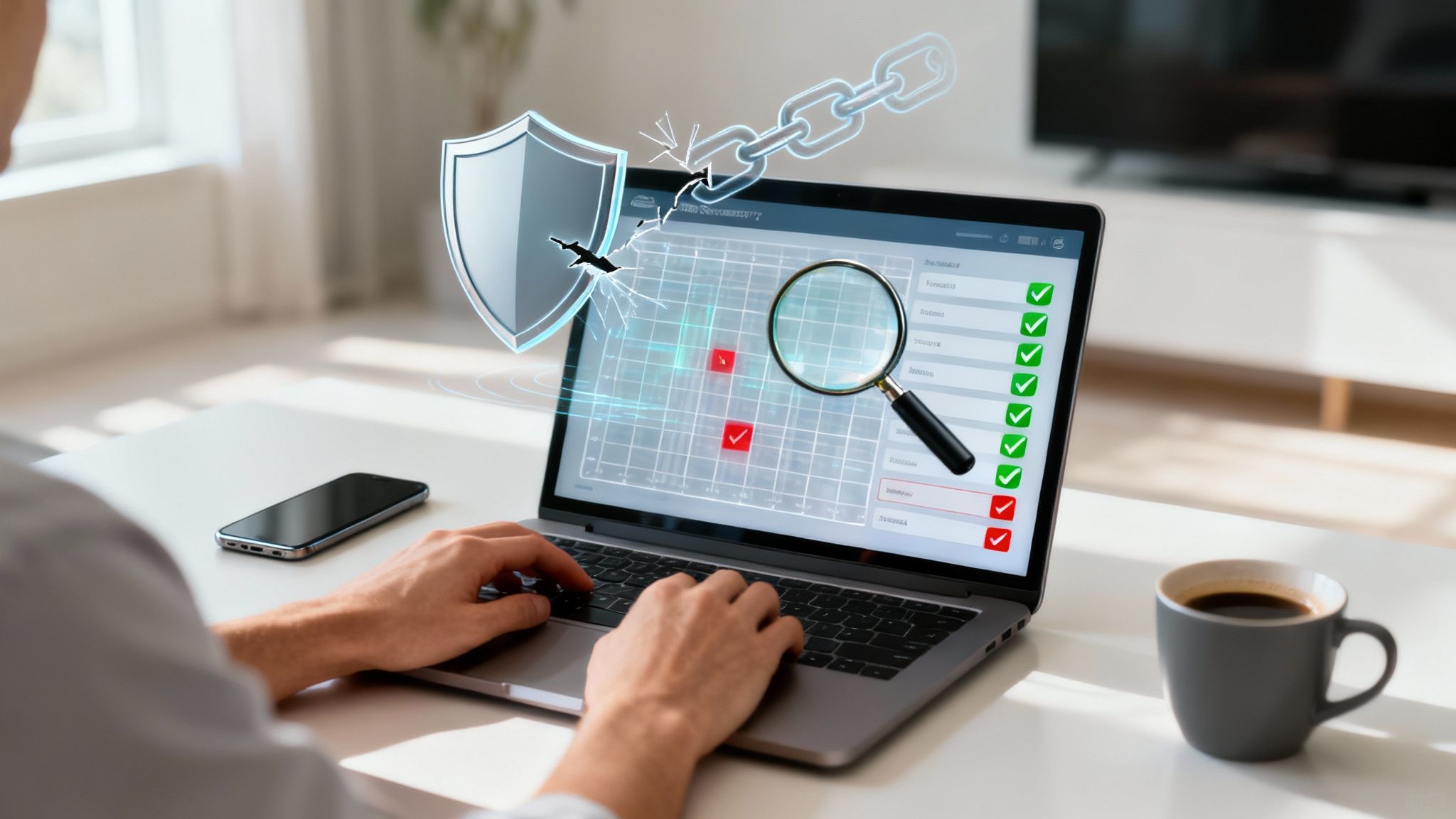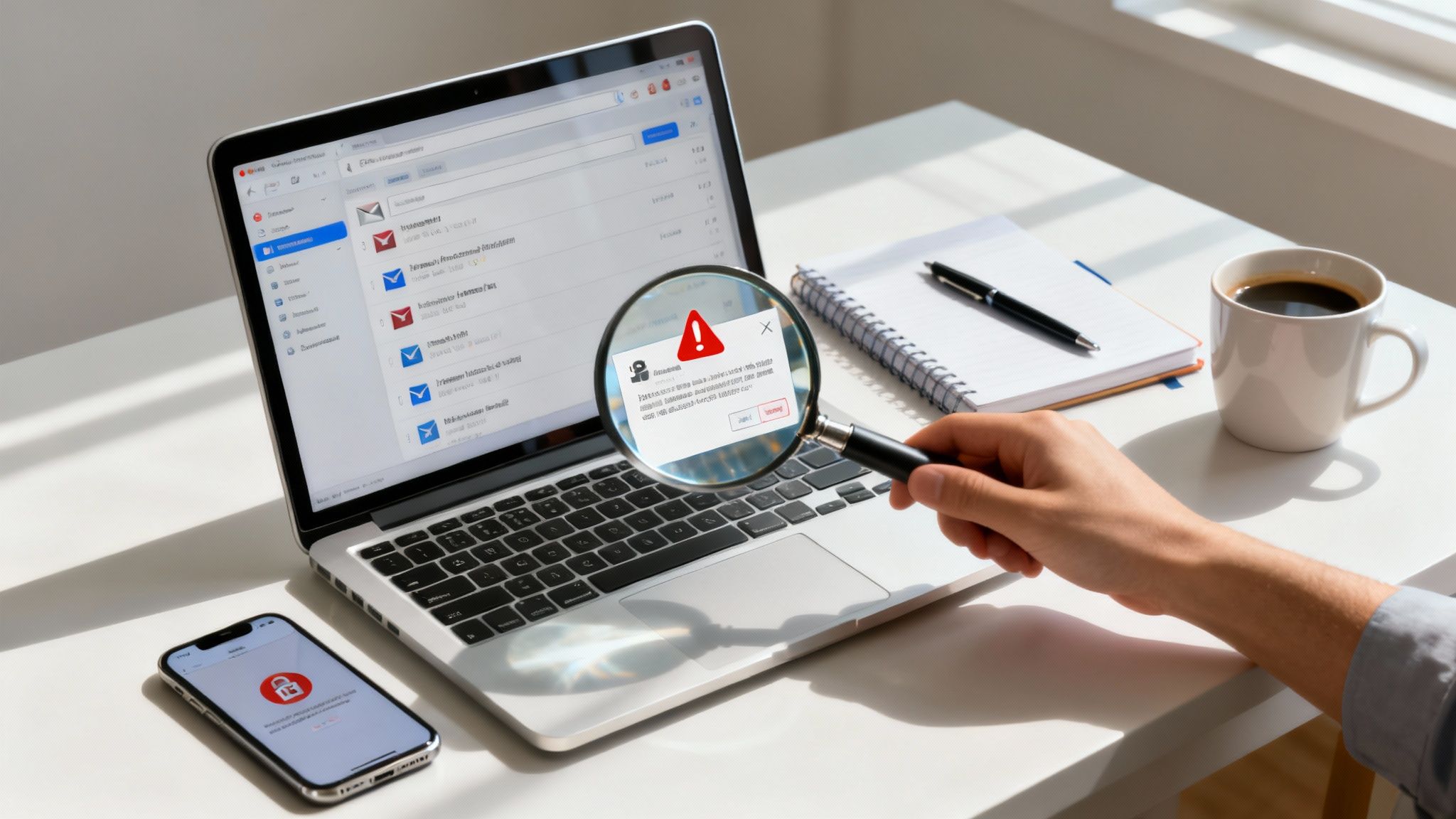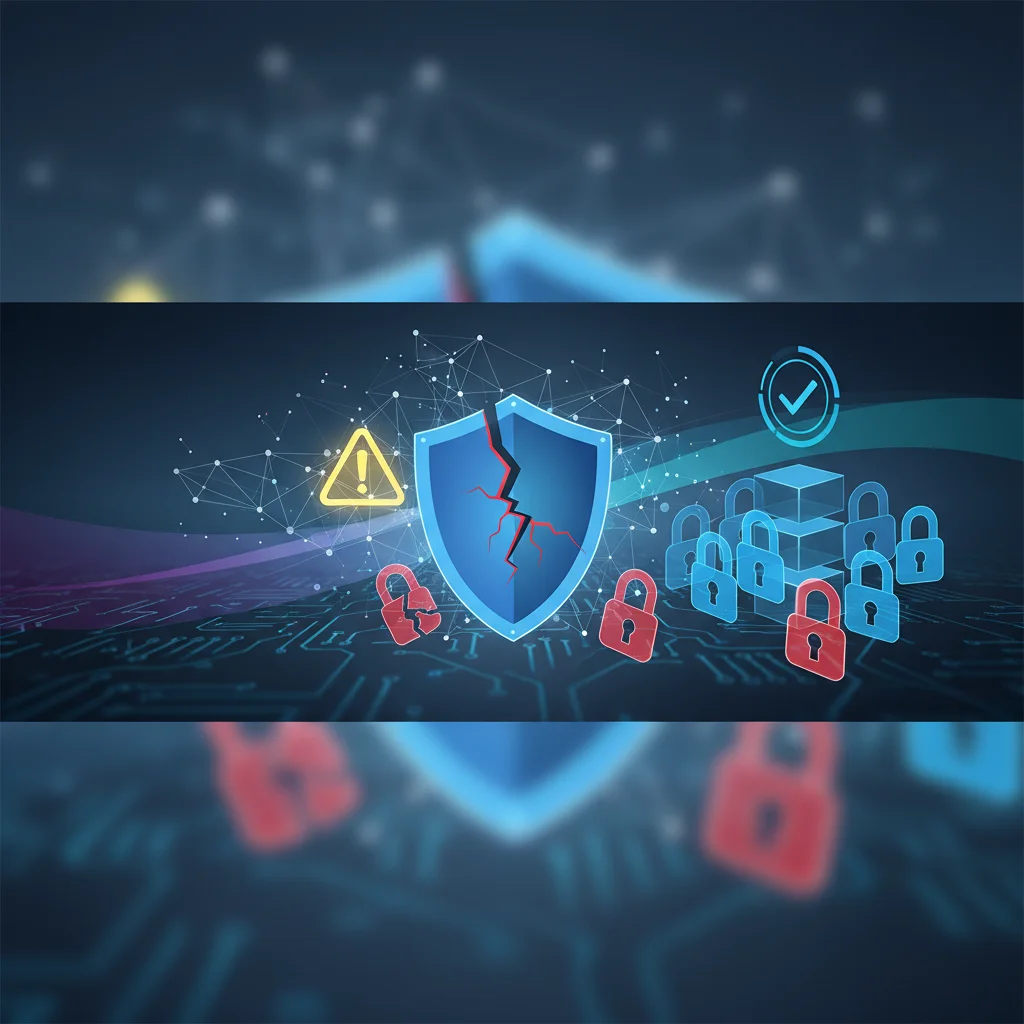· Digital Footprint Check · Content Marketing · 17 min read
What Is the Dark Web and How Does It Work? Complete Guide
Learn what is the dark web and how does it work. Discover onion routing, its uses, risks, and how to stay safe online. Get the facts now!

When people talk about the “dark web,” it conjures up all sorts of shadowy images. In simple terms, it’s a hidden corner of the internet that you can’t find using search engines like Google. Getting there requires special software, like the Tor browser, which uses a clever technology called onion routing to encrypt your activity and keep you anonymous. This setup makes it a magnet for both privacy advocates and those involved in illegal activities.
Exploring the Internet’s Hidden Layers
To really get a handle on the dark web, it helps to think of the entire internet as a giant iceberg.
Most of us spend our time on the very tip sticking out of the water. This is the Surface Web. It’s everything you can easily find through a standard search engine—news sites, your favorite blogs, e-commerce stores, you name it.
Just below the water is a much, much bigger section called the Deep Web. This part isn’t as sinister as it sounds. It’s simply all the online content that search engines can’t “see.” Think about your email inbox, your online banking portal, or a company’s private internal network. This is all password-protected stuff meant for specific users, not the general public.
The dark web is a tiny, intentionally hidden part of the deep web. It’s a whole separate network built on top of the regular internet, and you need special tools to even knock on the door.

As you can see, the dark web is just a sliver of the whole internet, but it’s the deliberate secrecy that truly sets it apart from everything else.
To make these distinctions even clearer, let’s break them down side-by-side.
The Three Layers of The Internet at a Glance
| Layer | What It Is | How You Access It | Example Content |
|---|---|---|---|
| Surface Web | The publicly accessible, indexed part of the internet. | Standard web browsers like Chrome, Firefox, or Safari. | News websites, public social media profiles, retail stores, blogs. |
| Deep Web | Content not indexed by search engines, often behind a login. | Standard web browsers, but requires authentication (username/password). | Online banking portals, email inboxes, medical records, private corporate databases. |
| Dark Web | Anonymized networks built on the internet, intentionally hidden. | Specialized software like the Tor browser. | Anonymous forums, encrypted communication channels, marketplaces. |
While the deep web is vast and mostly mundane, the dark web is specifically engineered for anonymity, which is what gives it its unique character.
The Technology Behind the Anonymity
You can’t just type a dark web address into Chrome and expect it to work. Accessing these hidden networks requires tools like the Tor browser. Tor uses a method called “onion routing” to wrap your data in multiple layers of encryption—like the layers of an onion—and bounce it through a worldwide network of volunteer-run computers.
This process makes it incredibly difficult for anyone to figure out who you are or where you’re coming from. For a deeper technical dive, you can find more insights on how the dark web is powered on deepstrike.io.
This powerful anonymity is the dark web’s defining feature. It’s what allows people to communicate and share information without worrying about surveillance or censorship.
The core principle is decentralization. Instead of a direct line from your computer to a website, your connection takes a winding, random path through multiple servers. This makes tracing the source or destination of the data next to impossible.
Because of this unique structure, dark web sites don’t use the familiar “.com” or “.org” domains. Instead, their addresses end in “.onion”. These aren’t registered with any central authority and usually look like a long, random jumble of letters and numbers that you could never remember. This design is intentional—it reinforces the network’s commitment to privacy and makes it much harder for anyone to find or shut down these sites.
How Onion Routing Creates Anonymity
 The secret ingredient that makes the dark web work is a clever process called onion routing. It’s the engine behind the Tor network’s impressive anonymity, and the name itself gives you a perfect picture of how it all comes together.
The secret ingredient that makes the dark web work is a clever process called onion routing. It’s the engine behind the Tor network’s impressive anonymity, and the name itself gives you a perfect picture of how it all comes together.
Think of it like sending a top-secret message. Instead of just dropping it in the mail, you put it in a small lockbox. You then hand that box to a courier, who places it inside another, slightly bigger lockbox before passing it along. This happens a few more times before the package finally reaches its destination.
That’s onion routing in a nutshell. Your data gets wrapped up in multiple, heavy-duty layers of encryption—just like the layers of an onion. Each layer corresponds to a specific stop on its trip across the internet.
The Journey Through Tor Nodes
When you use a tool like the Tor browser, your internet traffic doesn’t go straight from point A to point B. Instead, it’s sent on a wild, zigzagging path through a global network of volunteer-operated servers called nodes.
These nodes are the couriers in our lockbox analogy. Each one has a very specific job to do, and they fall into three main types:
- Entry Node (or Guard Node): This is the first server you connect to. It knows who you are (your real IP address), but it has absolutely no clue where your data is ultimately headed. It only knows the next random stop in the chain.
- Relay Node: These are the middlemen. A relay node gets the encrypted package, peels off one layer of encryption, and passes it to the next node. The crucial part? It knows nothing about where the package came from or where it’s going.
- Exit Node: This is the last stop. The exit node removes the final layer of encryption and sends your now-decrypted data to the website you wanted to visit. It sees the destination but has no way of knowing who you are or where you started.
This strict separation of knowledge is the entire point. No single server in the chain ever knows both who you are and what you’re doing online.
By breaking the link between your identity and your destination, onion routing makes it incredibly difficult for anyone spying on the network to trace activity back to a specific person.
Why This Method Is So Effective
The true strength of this system is its decentralized and layered design. The path your data takes is randomly generated every single time you start a new session, bouncing between multiple independent nodes all over the world. This makes any kind of surveillance a nightmare.
Someone watching the final exit node might see traffic heading to a particular website, but they can’t see who sent it. On the other hand, anyone monitoring your local internet connection might see you’re using Tor, but they won’t know which sites you’re visiting.
This powerful architecture provides a real, practical defense against tracking and is the very foundation of how the dark web protects user identity.
A Look Inside the Dark Web Ecosystem
 Once you get past the technical side of things like onion routing, what really defines the dark web is the people who use it and why they use it. At its core, it’s just a tool for anonymity. But what people do with that privacy has created a world of stark contrasts, a place of both incredibly constructive and deeply criminal activity.
Once you get past the technical side of things like onion routing, what really defines the dark web is the people who use it and why they use it. At its core, it’s just a tool for anonymity. But what people do with that privacy has created a world of stark contrasts, a place of both incredibly constructive and deeply criminal activity.
This duality is the key to understanding what the dark web really is. On one hand, it’s an absolute lifeline. For people living under the thumb of oppressive regimes, it’s a platform for speaking freely and getting information that would otherwise be completely blocked.
Journalists and whistleblowers count on its anonymity to share sensitive stories without getting tracked or punished. It’s become a modern digital sanctuary, a place where freedom of speech isn’t just a concept. That’s why major news outlets like the BBC and The New York Times even maintain their own .onion sites to ensure anyone, anywhere, can access their reporting.
The Legitimate Side of Anonymity
The positive side of the dark web often gets lost in the headlines, but it’s fundamental to why these privacy tools were created in the first place.
- Protecting Vulnerable Groups: Activists can plan protests and share information without being identified by authoritarian governments.
- Secure Whistleblowing: Insiders have a way to leak critical information about corporate or government wrongdoing to journalists through secure channels.
- Bypassing Censorship: Citizens in countries with heavy internet restrictions can get an unfiltered view of global news and social platforms.
But the very same shield of anonymity that protects the vulnerable also conceals a massive criminal underworld. The dark web is infamous for its marketplaces, which are basically illicit, anonymous versions of Amazon or eBay. These sites are the backbone of a robust underground economy built on illegal goods and services.
The very same features that empower activists and journalists—untraceable connections and untethered identities—also enable a vast network of illegal commerce and communication.
Transactions on these sites are almost always done with cryptocurrencies like Bitcoin and Monero to add another layer of privacy. To build a sliver of trust between anonymous buyers and sellers, many marketplaces use escrow systems. The payment is held by a third party and only released once the buyer confirms they’ve received the goods.
The Illicit Marketplaces
The scale of this illegal activity is huge, and it keeps growing. These marketplaces are a focal point for cybercrime, offering everything from stolen data to illegal drugs. As of 2022, there were an estimated 30,000 dark web sites, which is a 44% jump from just the year before.
This explosion includes around 1,000 active illicit drug markets and a mind-boggling repository of over 15 billion stolen credentials discovered in the first half of that year alone. If you want to see the full scope, you can dig into more dark web statistics at Market.us.
Ultimately, the dark web isn’t inherently good or evil. It’s a powerful tool, and its impact is shaped entirely by the people who use it. Understanding this dual nature is the only way to get a complete and accurate picture of this hidden corner of the internet.
Understanding the Real Risks and Dangers
While the technology behind the dark web is a neutral tool for privacy, don’t be fooled—the environment it creates is anything but risk-free. Venturing into this hidden corner of the internet unprepared is like walking through a minefield blindfolded. The same anonymity that protects journalists and activists also shields cybercriminals, turning it into a hotbed for some serious threats.
One of the most immediate dangers is malicious software. Malware, including nasty stuff like spyware, keyloggers, and ransomware, is often bundled into files or hidden in links on .onion sites. One wrong click could compromise your entire device, giving criminals a backdoor to your personal files, banking info, and passwords. These aren’t just passive risks; they are actively deployed to prey on unsuspecting visitors.
Technical and Personal Security Threats
Beyond malware, the dark web is absolutely crawling with clever scams. Phishing attacks are especially rampant, where criminals create convincing fake login pages for popular services or marketplaces just to steal your credentials. Because the entire ecosystem is built on anonymity, you have virtually no way to get your money back or seek justice if you’re tricked.
These technical problems are just the beginning. The personal security issues are just as serious:
- Identity Theft: This is a big one. Criminals openly buy and sell stolen personal information. If your data ends up in their hands, the consequences can be devastating. Learning how identity theft occurs is a critical first step in protecting yourself from this pervasive threat.
- Operational Security (OpSec) Failures: A single mistake is all it takes. Using a username you’ve used somewhere else or revealing a tiny personal detail in a forum post can completely unravel your anonymity, making you an instant target for hackers or even law enforcement.
- Exposure to Disturbing Content: It’s nearly impossible to browse the dark web for long without stumbling upon illegal or deeply unsettling material. This can include graphic violence and other forms of extreme content that can leave a lasting psychological mark.
The greatest risk often comes not from sophisticated hacks, but from simple human error. One moment of carelessness is all it takes to expose your identity and open the door to serious consequences.
Legal and Ethical Consequences
Finally, you can’t ignore the legal fallout. While just accessing the dark web isn’t illegal in most countries, engaging with—or even accidentally viewing—illicit content can lead to severe criminal charges. Law enforcement agencies are constantly monitoring these networks for illegal activity.
That sense of anonymity you feel on the dark web? It’s not a get-out-of-jail-free card. Understanding how this world works means accepting that your actions have very real, and potentially very serious, consequences.
The Underground Economy of the Dark Web
The same anonymity that shields users on the dark web also powers its most notorious feature: a sprawling, surprisingly sophisticated underground economy. This isn’t just a random collection of illegal posts; it’s a fully-fledged financial ecosystem with its own rules, currencies, and even business models. And at the heart of it all is cryptocurrency.
Digital currencies like Bitcoin and Monero are the lifeblood of these marketplaces. They enable pseudonymous, borderless transactions that are incredibly hard to trace back to real people, making them a perfect fit for an environment built on secrecy. This obsession with anonymity often pushes users toward platforms like crypto payment gateways without KYC, which don’t require identity verification and add another layer of obscurity.
The Scale of Dark Web Commerce
The sheer size of this underground market can be hard to wrap your head around. In 2024 alone, darknet markets around the world raked in just over $2 billion in on-chain Bitcoin payments. On top of that, specialized fraud shops—which focus on trading stolen financial data—pulled in another $225 million. You can dig deeper into these numbers with the latest darknet market trends on Chainalysis.com.
This financial activity isn’t just a free-for-all, either. Many marketplaces have systems in place to create a fragile sense of trust. For instance, most use an escrow service. When a buyer pays, their crypto is held by the marketplace itself and is only released to the seller once the buyer confirms they received what they ordered. This simple system helps cut down on scams and makes the economy more stable for everyone involved.
The Business of Cybercrime
Beyond one-off sales, the dark web has become a breeding ground for shockingly professional cybercrime operations. These aren’t just single deals; they are scalable, service-based businesses that run like twisted versions of legitimate tech companies.
- Ransomware-as-a-Service (RaaS): Developers create powerful ransomware tools and then lease them out to less-skilled criminals for a cut of the profits. This model drastically lowers the barrier to entry, allowing almost anyone to launch devastating cyberattacks.
- Fraud Shops: Think of these as online department stores for stolen data. They sell everything from credit card numbers and online banking logins to complete digital identities, often harvested from large-scale security breaches. If you’re worried about your own data, it helps to understand what a data breach really is and how it can expose you.
- Hacking for Hire: Need a website taken down or a competitor’s network infiltrated? There are individuals and groups offering their technical skills for a fee, ready to carry out tasks from simple denial-of-service attacks to complex corporate espionage.
As the cybercrime world has matured, the revenue streams have become more defined and shockingly lucrative. Research provides a glimpse into the scale of these illegal enterprises.
Top Dark Web Illicit Revenue Streams
| Activity Category | Estimated Annual Revenue (Cryptocurrency) | Primary Currency Used |
|---|---|---|
| Drug Trafficking | Over $1 Billion | Bitcoin (BTC), Monero (XMR) |
| Stolen Data Sales | $600 Million - $800 Million | Bitcoin (BTC), Ethereum (ETH) |
| Ransomware Payments | $400 Million - $500 Million | Monero (XMR), Bitcoin (BTC) |
| Financial Fraud Services | $200 Million - $300 Million | Bitcoin (BTC) |
| Hacking Services | $100 Million - $150 Million | Monero (XMR), Litecoin (LTC) |
These figures, while estimates, paint a clear picture of a highly profitable and diversified criminal economy operating just beneath the surface of the regular internet.
This commercialization has turned cybercrime into a collection of accessible, off-the-shelf products. It allows criminals to operate with the cold efficiency of a legitimate business, constantly adapting their methods to dodge law enforcement and exploit new vulnerabilities. The dark web provides the perfect, anonymous infrastructure for this economy to not just survive, but thrive.
How to Protect Your Data From Dark Web Threats
When you pull back the curtain on the dark web, one truth becomes crystal clear: the best way to keep your data from ending up there is to lock it down on the regular internet first.
Think about it. Most of the stolen information sold in those hidden marketplaces doesn’t come from the dark web itself. It’s snatched from breaches on the Surface Web—the everyday sites and services you use.
Proactive security is your best bet. It all starts with something simple but powerful: using strong, unique passwords for every single online account. Reusing a password is like handing a thief a master key to your entire digital life. If one account gets hit, they all become sitting ducks.
Fortify Your Digital Defenses
One of the most effective moves you can make is implementing two-factor authentication (2FA) wherever it’s offered. It’s a simple step that adds a massive barrier against anyone trying to get into your accounts, even if they somehow managed to steal your password.
You also need to get sharp at spotting phishing attempts. These scams, usually hiding in your email or text messages, are designed purely to trick you into handing over your login details.
Your personal data is only as secure as your weakest link. Simple, consistent security practices are far more effective than complex, rarely used tools.
For even better protection, you might want to look into services that actively hunt for your information online. We’ve put together a guide on the top tools for monitoring your digital footprint and keeping your data safe that can help. These tools can alert you the moment your credentials pop up in a known breach, giving you a critical head start to change your passwords and secure your accounts.
To round out your strategy, always use reliable security software and keep your apps and systems updated. By securing your presence on the Surface Web, you dramatically cut down the chances of your personal info ever showing up for sale on the dark web.
Dark Web Common Questions
It’s natural to have questions when you’re talking about the internet’s hidden corners. Let’s clear up some of the most common points of confusion about what the dark web is, how it works, and the real risks involved.
Is It Illegal to Access the Dark Web?
This is the big one. Just firing up a browser like Tor and poking around the dark web is not illegal in most countries. Think of Tor as just a tool for privacy, nothing more.
The real issue is what you do while you’re there. If you engage with, buy, or even just view illegal material, you’re breaking the law. The legality is all about your actions, not the simple act of looking.
What Is the Difference Between the Deep Web and the Dark Web?
People mix these two up all the time, but the difference is pretty simple. The deep web is just any part of the internet that a search engine like Google can’t find. This is mostly boring stuff you use every day—your online bank account, your email inbox, or a company’s private server.
The dark web is a very small piece of that deep web. It’s intentionally hidden and needs special software to get to it, mainly for anonymity.
In short: Everything on the dark web is part of the deep web, but almost none of the deep web is the dark web. It all comes down to whether it’s hidden on purpose.
Can I Be Tracked on the Dark Web?
While the Tor network is designed from the ground up for anonymity, it’s not a magic invisibility cloak. It’s incredibly difficult to track someone, but not impossible.
A government agency with massive resources might be able to de-anonymize a user with enough time and effort. But honestly, the much bigger risk comes from simple user error—accidentally sharing personal details, clicking a bad link, or downloading a malicious file. Absolute, 100% anonymity is never something you should count on.
Your data’s safety starts with knowing where it is. Digital Footprint Check scans the dark web for your exposed information, providing real-time alerts so you can take action before it’s too late. Start your free scan today and see what’s out there.



